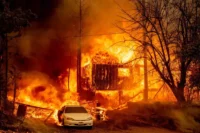
Una tragedia griega
Hay una pregunta, más que ninguna otra, que se agolpa en la mente de la mayoría de los griegos al contemplar la devastación del accidente de tren de esta semana, que ha dejado más de 40 muertos, en su mayoría jóvenes: ¿Cómo ha ocurrido?
Era la pregunta que se hacían los estudiantes que depositaban flores en la estación de tren de Salónica, adonde iban a llegar sus amigos tras celebrar el fin de semana de carnaval. Es lo que querían saber los padres que perdieron a sus hijos e hijas en el infierno provocado por el choque de un tren de pasajeros procedente de Atenas contra un tren de mercancías que circulaba en sentido contrario.… Seguir leyendo »
















